When the Parrish Art Museum moved to Water Mill from the location on Jobs Lane in Southampton that it had occupied since 1897, it was feared that the village had lost not just a cultural institution whose reputation had grown over the past 20 years, but also an irretrievable element of Southampton’s storied persona.
Thankfully, this void has been at least partially filled by the Levitas Center for the Arts at the Southampton Cultural Center, which for the past few years has presented singularly interesting exhibitions featuring prominent East End artists, thereby lessening the community’s loss when the Parrish closed its Italianate doors in Southampton in 2012.
In the current exhibition, “Abstraction: 4 Perspectives,” curated by Arlene Bujese, who has been arranging shows at the Cultural Center since 2010, the emphasis is (as the title suggests) on the manner in which four accomplished artists investigate the realms of non-objective painting. Interestingly, the different technical mannerisms notwithstanding, perhaps the most striking aspect of the exhibit is in the method in which each artist approaches the use of space in his or her works.
For Josh Dayton, the use of negative space as a means of emphasizing the impact of other areas of the canvas has become a singularly powerful component in his works. Dayton, who at various points in the past used ceramics and other sculptural motifs that were incorporated in the paintings’ surfaces, now creates depth and movement through a compelling interaction of painterly motifs melded with elements of collage.
This technique conjures, in these recent works, a gently melodic sensibility in which color and form seamlessly interact in choreographed configurations and where shapes serve to simultaneously juxtapose each other’s movements like dancers flung across the surfaces of the works. This creates, as Max Ernst once stated of collage and painting, “the noble conquest of the irrational, the coupling of two realities, irreconcilable in appearance, upon a plane which apparently does not suit them.”
In Flick (2013), for example, the artist creates a painterly ground that is divided into quadrants while the collaged elements float weightlessly above the surface of the canvas. The effect is one of a whimsical interaction of imagery that allows the various components to communicate in a distinctly rhythmic conversation that is simultaneously playful and complementary yet also assertively adversarial.
.
.
While these elements are also apparent in Hug and Smoker (both 2013), the artist accentuates in these works a more random and spontaneous configuration of the various cadenced components. This creates an effect that, while still harmonious, nevertheless allows more dissonant insinuations to become apparent, although at no time does the sensibility become overtly discordant.
.
.
There are similar overtones at play in Fulvio Massi’s works in the exhibition, as seen in his joining painterly and collage motifs together. Whereas Dayton’s works are softly mellifluous in their use of contrasts and juxtapositions, Massi’s tend to be more energetically frenetic in the interaction of materials and images.
.
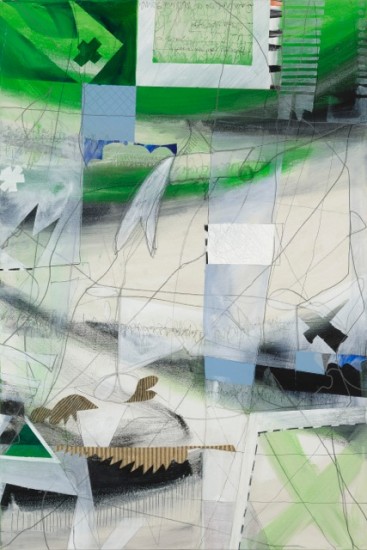
"Prima Vista" by Fulvio Massi, 2014. Acrylic, graphite and pastels on canvas. Courtesy of the artist.
.
At the same time, matching the spontaneous configurations of painterly and collaged components is a highly refined (though extremely subtle) sense of architectonic order that emanates from the works. This is particularly apparent in works such as Prima Vista and Synoptic (both 2014) while in others, such as Abacus, 2014, the prominent inclusion of calligraphic and figurative references creates a profoundly enigmatic sense of overt narrative.
.
.
Tracy Harris, by contrast, eschews overt narrative or tangible structure in her works, yet the sense of a mysterious sense of order nevertheless strongly radiates from deep within her swirls of color and line. And although this sense of compositional tension is a palpable element within the works, its inclusion doesn’t negate the joyous feelings of spontaneity and impulse that the artist uses to orchestrate the works themselves.
.
"Lexicon" by Tracy Harris, 2014. Encaustic and oil on panel, 30 x 30 inches. Courtesy of the artist.
.
In addition, in her use of oils and encaustics, Harris is able to create the entertaining sensation of depth within her paintings absent the inclusion of anything remotely connected to scientific perspective. In Marinus (2014), for example, this effect is accentuated and enhanced by the vigorous interplay of calligraphy and color that churns and spins in a spirited, and occasionally cacophonous, ballet of line and hue, while, simultaneously, the artist’s use of negative space draws the viewer’s eye deep into the center of the work.
.
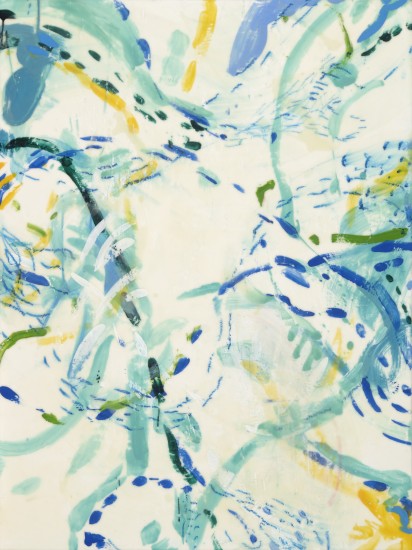
"Marinus" by Tracy Harris, 2014. Encaustic and oil on panel, 40 x 40 inches. Courtesy of the artist.
.
David Geiser, by contrast, provides an interesting comparison in that, while certain similarities exist between his and Harris’ use of surface texture, in some works Geiser seems more intent on almost completely erasing his physical presence and allowing a feeling of organic order to become dominant. Understating the presence of the artist’s hand, in such works as the Sea Surge Series or Ocean Flower Series (both 2014), there is a gentle flow to the manner in which color and space seem to ebb and flow into one another.
.

Panels from Ocean Flower and Sea Surge series by David Geiser, 2014. Oil, acrylic, varnish, pigment, gold leaf and mixed media on board. Courtesy of the artist.
.
This is also an arresting sensation in Uxmal (2010-11) although in this painting the artist forcefully imposes his own technical presence in the inclusion of a large drawn circle that floats above the surface of the work as if focusing all the energy of the piece into a spot somewhere within its geometric confines.
.
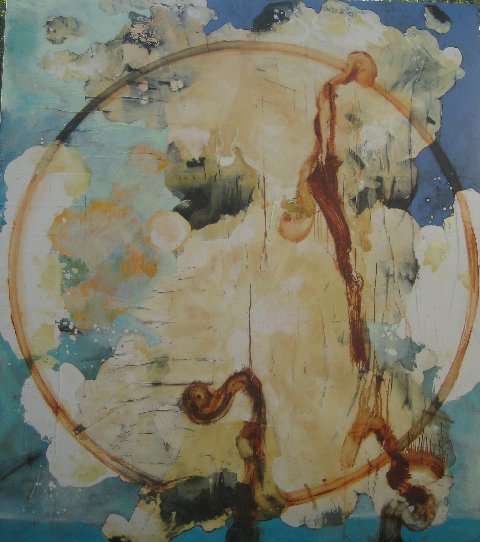
"Xumal" by David Gesier, 2010-11. Oil, acrylic, varnish, pigment, gold leaf and mixed media on board. Courtesy of the artist.
.
BASIC FACTS: “Abstraction: 4 Perspectives” is exhibited through May 20, 2014 at the Southampton Cultural Center, 25 Pond Lane, Southampton, NY 11968. The show is curated by Arlene Bujese. The gallery is open Monday through Saturday from 11 a.m. to 2:30 p.m. or by appointment. www.southamptonculturalcenter.org.
_________________________________________
Copyright 2014 Hamptons Art Hub LLC. All rights reserved.

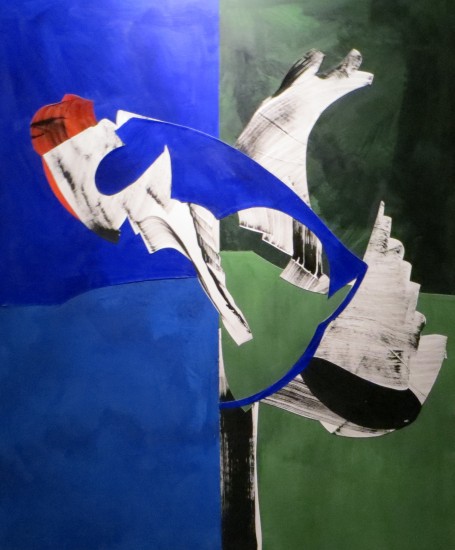

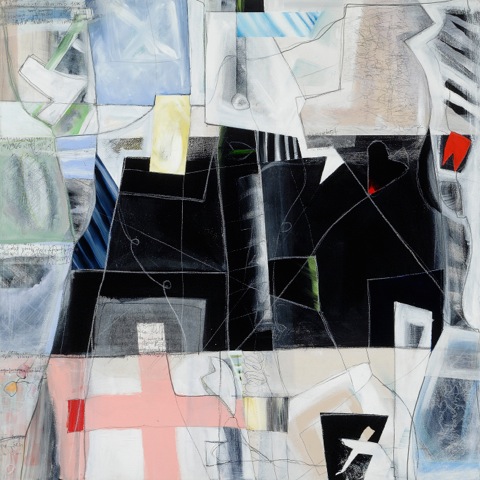
great presentations. Kudos!